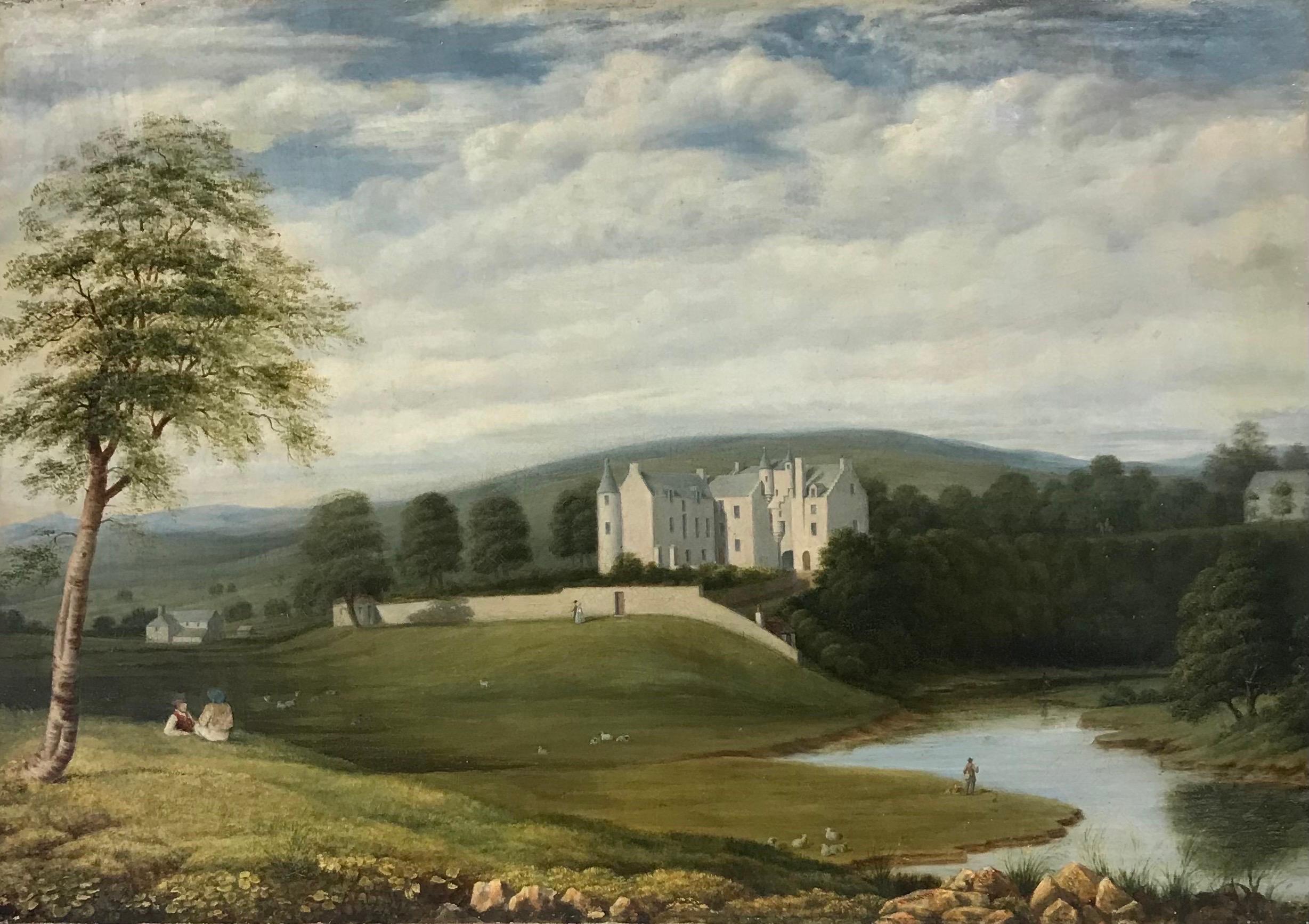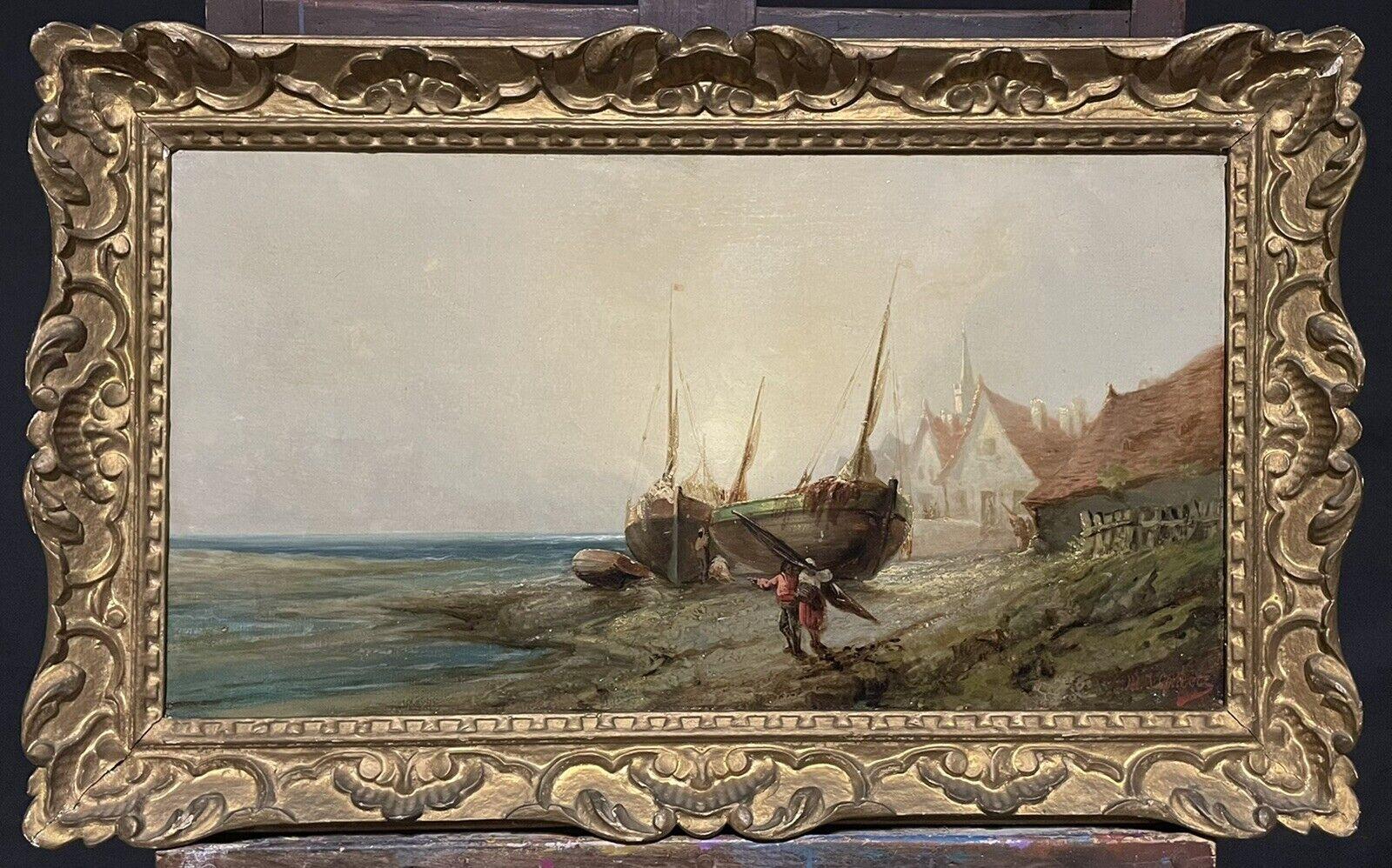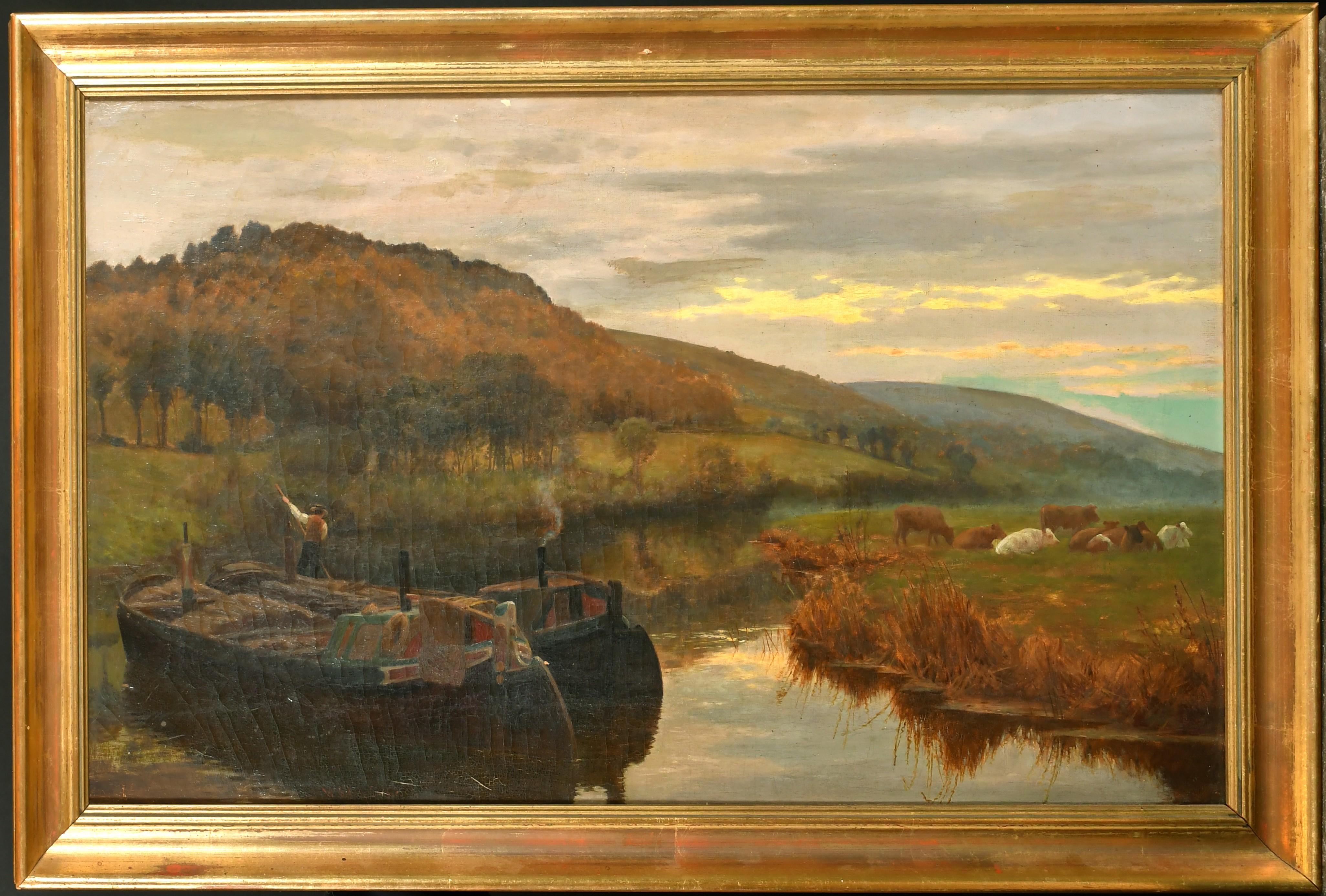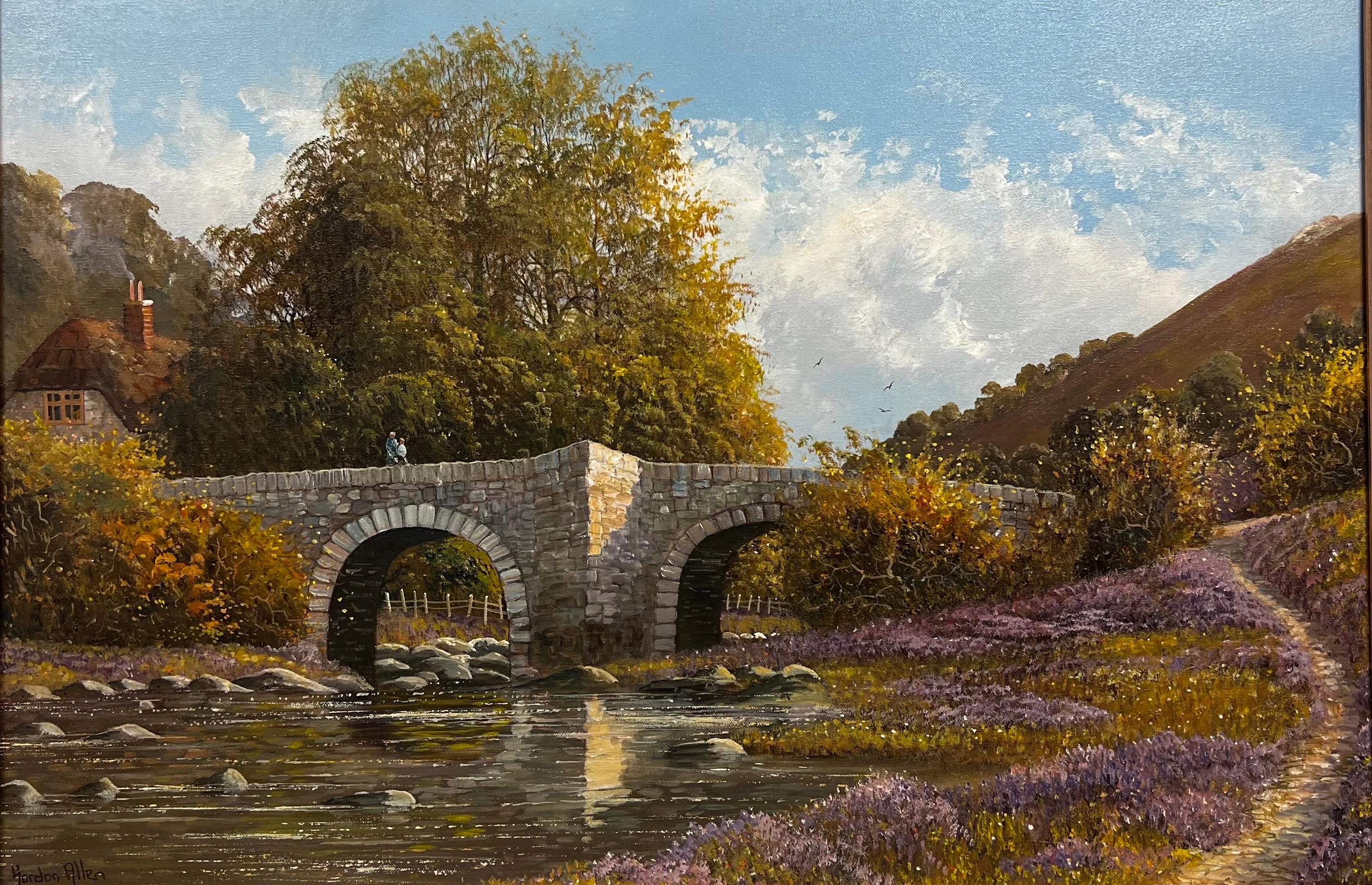Items Similar to David with the Head of Goliath, 19th Century Victorian Oil
Want more images or videos?
Request additional images or videos from the seller
1 of 6
John Rogers HerbertDavid with the Head of Goliath, 19th Century Victorian Oil1850
1850
About the Item
John Rogers Herbert RA
1810- 1890
Oil on canvas, dated '1850' lower right on sword strap
Image size: 33 ½ x 23 ½ inches
Gilt Watts frame
This striking painting, depicts David as a young boy holding behind his back the head of the champion of the Philistines, the giant Goliath, by the hair. The light catches on David's chest, arm and face, on the massive sword hilt of Goliath and the young tree behind, but everything else is quite dark. The two trees obviously represent David and Goliath, with the old larger tree dead and the green younger tree full of light and vigorous youth.
We see a very young courtier, a flamboyant youth of dazzling beauty and with a touch of arrogant defiance on his face. David is shown with his shepherds bag and stick, but also he holds a magnificently decorated but very heavy sword, given to him by King David. This sword evokes in the viewer the impression that the boy might have a great calling. David would indeed become the great warrior and king, the founder of the royal glory of Israel.
For a work painted in 1850 it has quite a surreal and modern feel to it and with its attention to detail you can see why he influenced the Pre Raphaelites.
The Artist:
John Rogers Herbert was born 23 January 1810 at Maldon in Essex. The family had enough money to send young Herbert to London when he was sixteen years old; and he was enrolled in the Royal Academy schools in December 1826. After the death of his father in 1828, Herbert was forced to give up the Academy school and began painting professionally – mostly book illustrations and portraiture. However, sketches from as early as 1829, such as Captives predict his later interest in larger historical subjects with challenging moral themes and complex compositions.
His first exhibit at the Royal Academy was in 1830, Portrait of a Country Boy.
Later in the decade, Herbert, like many of his contemporaries, displayed a growing interest in medievalism. One reason for this may be his friendship with A.W.N.Pugin who would become the co-architect of the Palace of Westminster and a proponent of medieval revival. Herbert and Pugin had known each other from childhood, and were very close, intimately involved in each other’s affairs.
At the age of 28 Herbert was already a success even painting a portrait of Princess Victoria in 1834. In 1841 Herbert was elected an Associate of the Royal Academy, and became a full member in 1846.
Herbert was a prolific teacher of art. In 1841 he became ‘master of the figure’ in the newly formed Government School of Design, a position probably owed to his artist friend William Dyce who was superintendent there, and with whom he collaborated in the illustration of Nursery Rhymes, Tales and Jingles.
Herbert was earnest and methodical in both his subjects and his technique. Evidence of this earnest practice can be found in the extensive research Herbert undertook for many of his paintings. He travelled to the East many times to paint the landscape, clothing and architecture of the area, in order to add authenticity to his biblical scenes.
Herbert’s innovative techniques, borrowing from mediaeval, German and Nazarene art influenced the young Herbert’s innovative techniques, borrowing from mediaeval, German and Nazarene art influenced the young Pre-Raphaelite Brotherhood. He instructed all the young members of the Brotherhood during their sojourn at the Royal Academy Schools, he gave personal support to James Collinson, and perhaps other members, during the formation of the Brotherhood, and was even a potential proprietor of The Germ. Yet, when W.M. Rossetti declared they wished to ‘out-Herbert Herbert’ he had more aesthetic and theoretical considerations in mind. The Pre-Raphelites drew on Herbert’s historical subjects of the 1840s for inspiration, and his influence can be especially seen in their early pictures.
- Creator:John Rogers Herbert (1810 - 1890, British)
- Creation Year:1850
- Dimensions:Height: 33.5 in (85.09 cm)Width: 23.5 in (59.69 cm)
- More Editions & Sizes:1 of 1Price: $31,021
- Medium:
- Movement & Style:
- Period:
- Condition:
- Gallery Location:London, GB
- Reference Number:1stDibs: LU5247319882
About the Seller
5.0
Gold Seller
These expertly vetted sellers are highly rated and consistently exceed customer expectations.
Established in 2007
1stDibs seller since 2014
66 sales on 1stDibs
Typical response time: 3 hours
- ShippingRetrieving quote...Ships From: London, United Kingdom
- Return PolicyA return for this item may be initiated within 14 days of delivery.
More From This SellerView All
- Ophelia, Victorian 19th Century Royal Academy Oil PaintingLocated in London, GBOil on canvas, signed lower right Image size: 33 1/2 x 56 1/2 inches (85 x 143 cm) Original gilt frame Provenance With the artist's son, Millie Dow Stott Esq., until 1912. Artist's Studio Sale, Christies, November 1913. Private Collection Exhibitions London, Royal Academy, 1895, no. 679. Paris, Societe de la Nationale des Beaux-Arts, 1896, no. 1179. Berlin, VII Internationale Kunstausstellung 1897. no. 3533. Manchester, City of Manchester Art Gallery, 1912, no. 339. In the 1890s William Stott exhibited regularly at the Royal Academy, mainly highly decorative works with subjects derived from classical mythology and literature. This painting was Stott's 1895 entry to the Royal Academy and was subsequently exhibited at the Paris Salon of 1896 and then on to the Berlin, VII Internationale Kunstausstellung 1897. Shakespeare was a favourite source for Victorian painters, and the tragic romance of Ophelia, from Hamlet, was an especially popular subject, featuring regularly in the Royal Academy exhibitions. The most popular and iconic image of Ophelia's death was, and is to this day, John Everett Millais's 1851 painting showing the confused and tragic Ophelia floating downstream on her back in a state of mad ecstasy, arms raised in a gesture of inevitable submission. However, although Stott chose not to pastiche this image, it seems highly likely that he was prompted to take up this subject, which had almost become a 'rite of passage' among Victorian painters, by the fact that in 1894 Millais's Ophelia was presented to the National Gallery of British Art by Sir Henry Tate. It appears that Stott was much influenced by John William Waterhouse...Category
Late 19th Century Victorian Figurative Paintings
MaterialsCanvas, Oil
- Study for Eastward Ho!, Oil on Panel 19th Century PaintingLocated in London, GBOil on panel Image size: 20 x 16 inches (51 x 40.5 cm) Handmade gilt frame Provenance Family estate This preliminary oil sketch for one of O'Neil's most famous works, "Eastward Ho!...Category
19th Century Victorian Figurative Paintings
MaterialsPanel, Oil
- Moonlight Scene with FishermenLocated in London, GBOil on canvas Image size: 23 1/2 x 18 1/2 inches (60 x 47 cm) Original frame This moonlit view features many of the usual features of Sebastian Pether's work: a painterly river, mountain scenery and the incorporation of classical gothic ruins in an attractive though artificial style. The ruins in the foreground and city in the background have been painstakingly depicted in meticulous detail. On the bank in the foreground, and out on the river itself, we see three night fishermen silhouetted against the calm waters. The artist has cleverly balanced the light emanating from the moon, and the reflection of this light glistening on the river surface below, to create the mysterious atmosphere of the moonlit evening. Indeed, he has skilfully employed the strong use of chiaroscuro effects of light and shade in this painting so that the eye is drawn to the full moon as it illuminates the sky. It is undeniably a work of Romanticism, a style that was popular around the beginning of the nineteenth century. The Artist Sebastian Pether was an English landscape-painter. He was the eldest son of Abraham Pether...Category
Early 19th Century Victorian Landscape Paintings
MaterialsOil, Canvas
- Turkish Scene, 19th Century British School VictorianLocated in London, GBBritish School 19th Century Turkish Scene Oil on board Image size: 13 ½ x 10 ½ inchesCategory
19th Century Victorian Landscape Paintings
MaterialsBoard, Oil
- The New Teacher, 19th Century Victorian Interior OilLocated in London, GBGeorge Bernard ONeil 1828-1917 Oil on canvas, signed & dated (18)76 lower right Image size: 22 ½ x 17 inches Original frame The painting depicts the arrival of the new teacher, a curious pupil peeps around a door to see her, while her friends look through the open door to the classroom to catch a glimpse. The artist has gone to great lengths with the painting, such as the highly detailed Dutch tiles on the bottom right of the picture or the window above the door in the background. O'Neil often painted works with several doorways leading off and giving a sense of depth to the work. The use of light and shadow is also cleverly depicted across the work, one light source arrives from where the viewer stands filling the room and the new teacher with light, while the other window above the door in the background also gives a warm glow. George Bernard O'Neill was born on 17th July 1828 in Dublin the ninth of fifteen children of Bernard and Sarah O...Category
1870s Victorian Landscape Paintings
MaterialsOil
- Looking across Buttermere, Victorian 19th Century Oil LandscapeBy John Atkinson GrimshawLocated in London, GBJohn Atkinson Grimshaw 1836 - 1893 Looking across Buttermere Oil on canvas, signed & dated '1868' lower right Image size: 13 ½ x 20 ½ inches (34.2 x 50.5 cm) Hand made gilt frame This work is dated 1868 making it one of his early works, painted during the same period as Grimshaw's other Lake District paintings...Category
1860s Victorian Landscape Paintings
MaterialsOil
You May Also Like
- Cornish Fisherwoman with Net, Victorian Painting by D.W. HaddonBy David W. HaddonLocated in Long Island City, NYA late Victorian period painting by British artist, David W. Haddon, active (1884-1914). The canvas measures 20 x 14 inches and is signed low...Category
Late 19th Century Victorian Figurative Paintings
MaterialsOil, Canvas
- Fine Early 1800's Scottish Pastoral Landscape Ancient Castle Figures & SheepLocated in Cirencester, GloucestershireArtist/ School: Scottish School, early 19th century Title: a large panoramic Scottish landscape, with ancient castle standing to the centre, with various figures enjoying the landsc...Category
Early 19th Century Victorian Landscape Paintings
MaterialsOil
- 19th Century French Signed Oil, Fishing Folk on the Shore at Sunrise by BoatsLocated in Cirencester, GloucestershireArtist/ School: French School, 19th century, indistinctly signed lower right corner. Title: Sunrise on the Beach Medium: signed oil painting on canvas, framed. framed size: 18 x...Category
19th Century Victorian Landscape Paintings
MaterialsOil
- Victorian Oil Painting Barge Boats by Pastoral River Sunset Cattle GrazingLocated in Cirencester, GloucestershireArtist/ School: 19th Century English School Title: Barges In A River Landscape at Sunset, Cattle resting in pastoral landscape Medium: o...Category
19th Century Victorian Landscape Paintings
MaterialsOil
- 19th Century genre oil painting of children gathering berriesBy William BromleyLocated in Nr Broadway, WorcestershireWilliam Bromley British, (1816-1890) Gathering Hawthorn Berries Oil on canvas, signed Image size: 27.5 inches x 35.5 inches Size including frame: 33.5 inches x 41.5 inches A love...Category
19th Century Victorian Figurative Paintings
MaterialsCanvas, Oil
- Tranquil English River Landscape with old Stone Bridge, signed original oilLocated in Cirencester, GloucestershireArtist/ School: by Gordon Allen, British late 20th century Title: The Old Stone Bridge Medium: oil on canvas, framed Framed: 25 x 35 inches Canvas : 2...Category
20th Century Victorian Landscape Paintings
MaterialsOil
Recently Viewed
View AllMore Ways To Browse
The Head
With The Head Of
Great Art Of The 19th Century
David Head
Old Victorian Art
Full Of Money
King David
Black Painted Victorian
Victorian Family Painting
Victorian Illustration
Victorian Antique Illustrations
Large German 19th Century Painting
Victorian Death Painting
Palace Scene Oil
Very Large Late 19th Century Oil Painting
1850 Oil Portrait
Medieval Head
Rogers Oil Paintings




